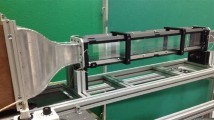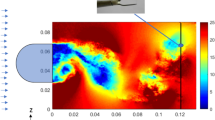Abstract
The increasing capabilities of currently available high-speed cameras present several new opportunities for particle image velocimetry (PIV). In particular, temporal postprocessing methods can be used to remove spurious vectors but can also be applied to remove inherent noise. This paper explores this second possibility by estimating the error introduced by several denoising methods on manufactured velocity fields. It is found that PIV noise, while autocorrelated in space, is uncorrelated in time, which leads to a significant improvement in the efficiency of temporal denoising methods compared to their spatial counterparts. Among them, the optimal Wiener filter presents better results than convolution- or wavelet-based filters and has the valuable advantage that no adjustments are required, unlike other methods which generally involve the tuning of some parameters that depend on flow and measurement conditions and are not known a priori. Further refinements show that denoised data can be successfully deconvolved to increase the accuracy of remaining small-scale velocity fluctuations, leading in particular to the recovery of the true shape of turbulent spectra. In practice, the computation of the filter function is not always accurate and different procedures can be used to improve the method depending on the flow considered. Some of them are derived from the properties of the time-frequency spectrum provided by the wavelet transform.





















Similar content being viewed by others
References
Addison P, Murray K, Watson J (2001) Wavelet transform analysis of open channel wake flows. J Eng Mech-ASCE 127:58–70
Addison PS (2002) The illustrated wavelet transform handbook. Institute of Physics Publishing, USA
Adrian RJ (1995) Limiting resolution of particle image velocimetry for turbulent flow. In: Advances in turbulence research. Proceedings of 2nd turbulence research association conference on Pohang Inst. Tech., pp 1–19
Adrian RJ (2005) Twenty years of particle image velocimetry. Exp Fluids 39:159–169
Bellofiore A, Donohue E, Quinlan N (2011) Scale-up of an unsteady flow field for enhanced spatial and temporal resolution of PIV measurements: application to leaflet wake flow in a mechanical heart valve. Exp Fluids (to appear)
Chakraborty P, Balachandar S, Adrian RJ (2005) On the relationship between local vortex identification schemes. J Fluid Mech 535:189–214
Falchi M, Romano G (2009) Evaluation of the performance of high-speed PIV compared to standard PIV in a turbulent jet. Exp Fluids 47:509–526
Farge M (1992) Wavelet transforms and their application to turbulence. Annu Rev Fluid Mech 24:395–457
Fore L, Tung A, Buchanan J, Welch J (2005) Nonlinear temporal filtering of time-resolved digital particle image velocimetry data. Exp Fluids 39:22–31
Foucaut J, Carlier J, Stanislas M (2004) PIV optimization for the study of turbulent flow using spectral analysis. Meas Sci Technol 15:1046–1058
Fung JCH, Hunt JCR, Malik NA, Perkins RJ (1992) Kinematic simulation of homogeneous turbulence by unsteady random Fourier modes. J Fluid Mech 236:281–318
Green MA, Rowley CW, Haller G (2007) Detection of lagrangian coherent structures in three-dimensional turbulence. J Fluid Mech 572:111–120
Haller G (2002) Lagrangian coherent structures from approximate velocity data. Phys Fluids 14:1851–1861
Henning A, Ehrenfried K (2008) On the accuracy of one-point and two-point statistics measured via high-speed PIV. In: 14th International symposium on applications of laser techniques to fluid mechanics, Lisbon
Herpin S, Wong CY, Stanislas M, Soria J (2008) Stereoscopic PIV measurements of a turbulent boundary layer with a large spatial dynamic range. Exp Fluids 45:745–763
Katul G, Parlange M, Chu C (1994) Intermittency, local isotropy, and non-Gaussian statistics in atmospheric surface layer turbulence. Phys Fluids 6:2480–2492
Keane R, Adrian R (1990) Optimization of particle image velocimeters. Part I: Double pulsed systems. Meas Sci Technol 1:1202–1215
Keane R, Adrian R (1991) Optimization of particle image velocimeters. Part II: Multiple pulsed systems. Meas Sci Technol 2:963–974
Keane R, Adrian R (1992) Theory of cross-correlation analysis of PIV images. Appl Sci Res 49:191–215
Lavoie P, Avallone G, De Gregorio F, Romano GP, Antonia RA (2007) Spatial resolution of PIV for the measurement of turbulence. Exp Fluids 43(1):39–51
Lecordier B, Demare D, Vervisch L, Reveillon J, Trinite M (2001) Estimation of the accuracy of PIV treatments for turbulent flow studies by direct numerical simulation of multi-phase flow. Meas Sci Technol 12(9):1382–1391
Prasad AK, Adrian RJ, Landreth CC, Offut PW (1992) Effect of resolution on the speed and accuracy of particle image velocimetry interrogation. Exp Fluids 13:105–116
Press WH, Flannery BP, Teukolsky SA, Vetterling WT (1992) Numerical recipes in Fortran 77: the art of scientific computing. Cambridge University Press, Cambridge
Raffel M, Willert CE, Kompenhans J (2002) Particle image velocimetry: a practical guide. Springer, Berlin
Son S, Kihm K (2001) Evaluation of transient turbulent flow fields using digital cinematographic particle image velocimetry. Exp Fluids 30:537–550
Studer G, Arnal D, Houdeville R, Seraudie A (2006) Laminar-turbulent transition in oscillating boundary layer: experimental and numerical analysis using continuous wavelet transform. Exp Fluids 41:685–698
Vaseghi SV (2009) Advanced digital signal processing and noise reduction. Wiley, London
Vétel J, Garon A, Pelletier D, Farinas MI (2008) Asymmetry and transition to turbulence in a smooth axisymmetric constriction. J Fluid Mech 607:351–386
Vétel J, Garon A, Pelletier D (2010) Vortex identification methods based on temporal signal-processing of time-resolved PIV data. Exp Fluids 48:441–459
Westerweel J, Draad A, van der Hoeven J, van Oord J (1996) Measurement of fully-developed turbulent pipe flow with digital particle image velocimetry. Exp Fluids 20:165–177
Willert CE, Gharib M (1991) Digital particle image velocimetry. Exp Fluids 10:181–193
Author information
Authors and Affiliations
Corresponding author
Rights and permissions
About this article
Cite this article
Vétel, J., Garon, A. & Pelletier, D. Denoising methods for time-resolved PIV measurements. Exp Fluids 51, 893–916 (2011). https://doi.org/10.1007/s00348-011-1096-0
Received:
Revised:
Accepted:
Published:
Issue Date:
DOI: https://doi.org/10.1007/s00348-011-1096-0




